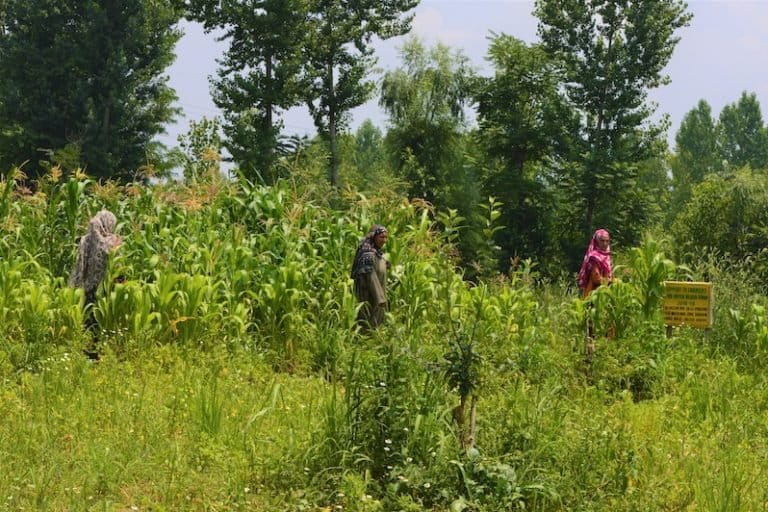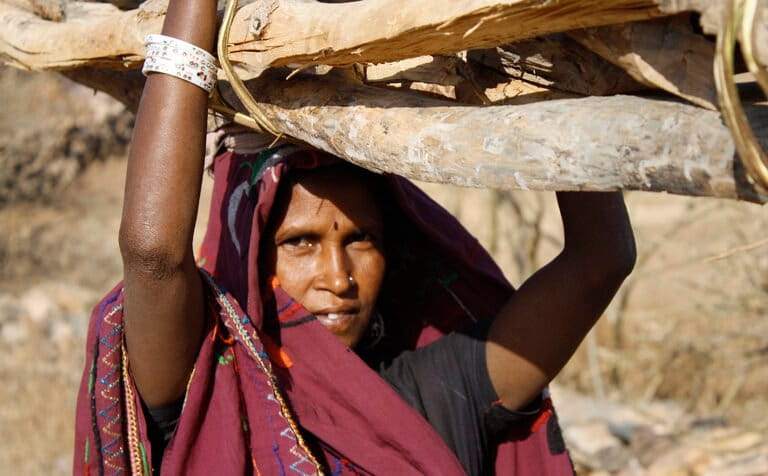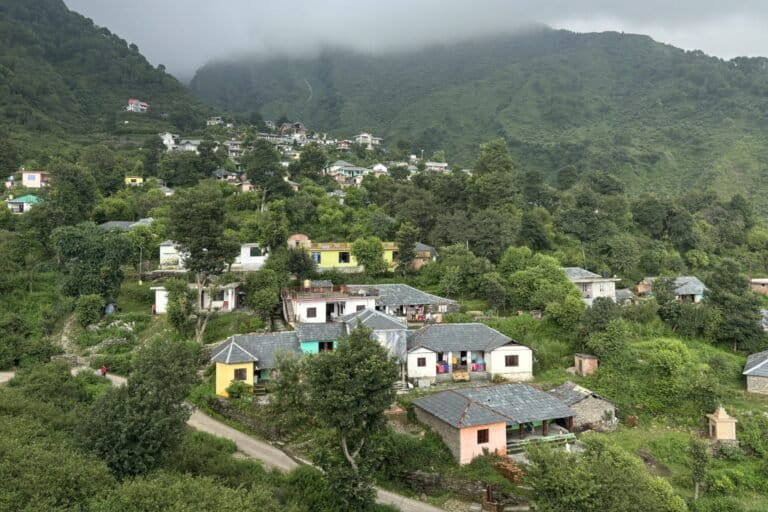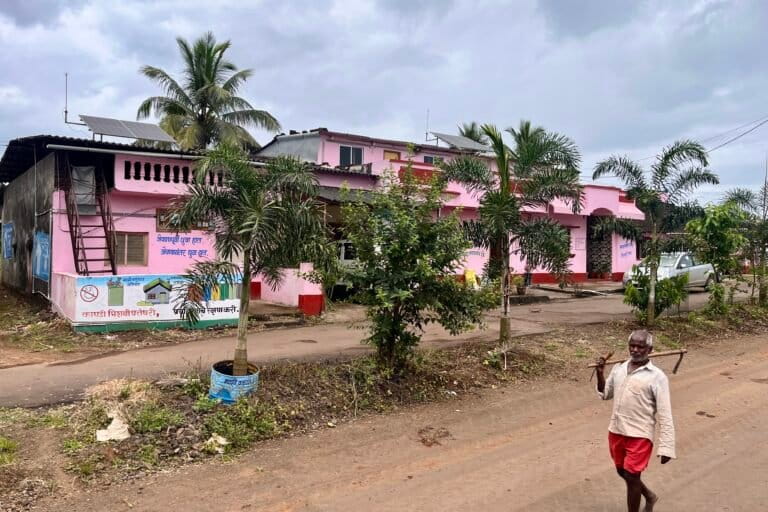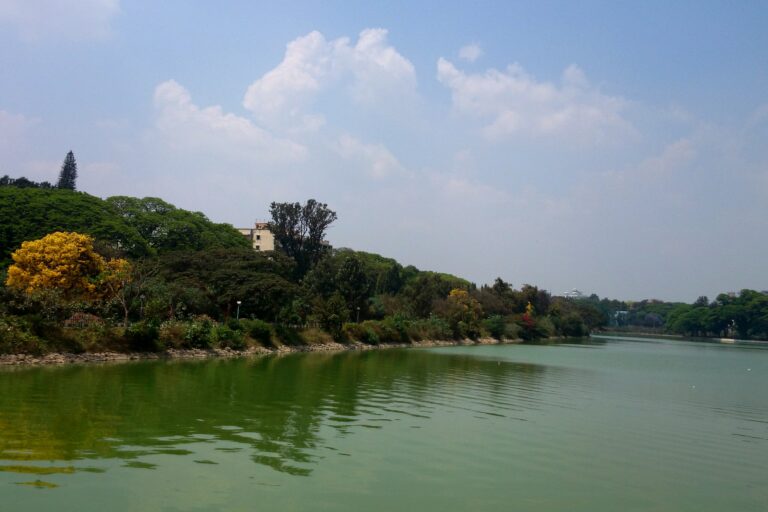- Brick kilns in many districts of Jammu and Kashmir are increasing air pollution and causing degradation of agricultural land.
- This has been causing increased morbidity and fatalities due to respiratory and other illnesses.
- There is also promise in the recent years, with a few examples of agricultural extension officials having worked with farmers to start farming back on land that was abandoned after use by brick kiln owners.
Haji Abdul Gaffar, 74, recalls the time when his village (Batpora-Budgam) and all the adjacent villages used to be lush green and free of pollution. It was around 40 years ago, when there were no brick kilns in Budgam, located not far from Srinagar, the capital of Jammu and Kashmir. The village now hosts over 200 brick kilns, all of them without the environmental (pollution) clearance from Jammu and Kashmir government’s Pollution Control Board.
These days, said Gaffar, most of the land in Budgam is degraded. The observations of the elderly man are not far from reality. While passing through the district, one can see huge areas of degraded land dotted with brick kilns which regularly billow thick smoke.
In some areas, agricultural land has been reduced to large pond-like structures with deep-digging. Experts like Shakil Romshoo of Kashmir University’s Earth Sciences Department say that the land in agricultural belts cannot be dug beyond two to three feet whereas the brick kiln owners dig the land as deep as 15 to 25 feet.
What Gaffar observes these days around his village is a total contrast to his experience when he was young. “In those years, there was no fear of [respiratory] diseases because of pollution. The crops and trees in our orchards were also not getting damaged by pollution,” Gaffar told Mongabay-India.
“Now when we look around, everything appears bad. The land has degraded as we have lost a lot of good soil. At most of the places in our district (Budgam), digging of land has been going on for years now,” the septuagenarian added.
Referring to the issues his family is facing at their three-acre apple orchard in the vicinity of 30 brick kilns, Gaffar said that the leaves of his orchard trees get damaged because of the soot coming from the brick kilns.
“The pollution and the soot blackens the leaves of apple trees and causes a lot of damage to many of them every year which affects the yield as well,” Gaffar said and added that two brick kilns stopped functioning a few years ago in Chinpora village of Budgam which left a positive impact on a nearby orchard.
According to him, the pollution from brick kilns in the Budgam district is also causing respiratory diseases among people especially among children and elderly people. “I know so many many people who died of chest diseases in our area (Batpora),” he said.
The hospital records also corroborate Gaffar’s observations. For example, in Block Khan Sahab alone, as many as 8,307 patients with chronic respiratory diseases have been treated (with some of them referred to the only tertiary hospital in Kashmir, Sher-e-Kashmir Institute of Medical Sciences or SKIMS) from January 2015 to March 2019.

Double whammy of air pollution and land degradation
Residents of the villages in Budgam, where brick kilns are located, say that people know of the consequences of the brick kiln pollution in Budgam, but a concerted campaign has not been launched so far for removing the brick kilns from their villages. “Everybody in our area knows how the brick kilns hurt us. I am surprised why we are not making a demand for their removal,” Bashmir Ahmad Sofi, a resident of Batpora said.
But, some villagers in adjacent villages have taken up the issue with the official authorities in recent years. In May this year, the district development commissioner (DDC) Budgam had urged the concerned officials to ensure that the ban on illegal brick kilns, stone crushers and mining of earth, sand and boulders across the district is implemented, but to no avail.
As per the rules of the Jammu and Kashmir Brick Kilns Regulation Act 2010, a brick kiln cannot be established on agricultural land. Further, securing no objection certificates (NOCs) from departments such as forest, agriculture, health and education is a must besides the permission from the concerned deputy commissioner.
Almost all the brick kilns in other districts of Kashmir such as Anantnag, Baramullah, Pulwama and Kulgam are also functioning without environmental clearances and licenses. For instance, 52 of the 56 brick kilns in Anantnag and all the 35 brick kilns in Pulwama district are functioning without licenses and environmental clearances.
Manoj Kumar Dwivedi, the commissioner secretary of forests and environment in Jammu and Kashmir government said that his department is working on a plan to deal with the brick kiln pollution.
“Yes, we are aware of the brick kiln pollution in Kashmir. People in Budgam district, which has the highest number of brick kilns, are particularly facing this problem (air pollution and soil erosion). The number of brick kilns we have in Budgam district, is more than we have in rest of Jammu & Kashmir,” Dwivedi told Mongabay-India.
According to him, nobody (no government) stopped the unauthorised functioning of brick kilns until it resulted into heavy pollution and a lot of erosion in the soil.
“We have to think how the degraded and eroded land can be treated and we are also now thinking of coming up with very stringent conditions for pollution control. We are now going to get zigzag technology in brick kilns so that pollution from brick kilns is minimised,” he said and added that some states like Punjab have already started working on it and “we will also make it mandatory that such technologies are adopted if the brick kilns have to operate.” He went on to say that brick kilns will be no more allowed to operate without environmental clearances.
According to Dwivedi, pollution monitoring instruments will be also installed in various districts in Kashmir for checking the air pollution levels. “Access to data and information from new research is seriously lacking in our region. For example, even Srinagar district does not have a pollution monitoring unit. Sometime back the device was installed, but it didn’t work and needed replacement which we have not been able to do so far,” he said.

A good example
In Watervani village of Budgam district, 10 acres of land was used by brick kiln owners for several years. Three years ago, when the land became unsuitable for brick-making, the brick kiln owners abandoned the land and stopped renewing the rent contract with the 12 farmers who had rented their land to them.
The farmers thought the land was not good enough for growing crops and left the land as such until local officers of agriculture department approached them and told them the department can help them treating the land under its climate change adaptation programme.
“This land had totally degraded as the brick kiln owners had dug so deep. Farmers were not sure what to do with the land. We provided them organic fertilizers as also seeds of leguminous crops like peas and beans for two years, which helped the treating the land,” Firdous Ahmad, district agricultural extension officer of Budgam, told Mongabay-India.
“From this year, we told them that they can grow oats and maize which they are doing,” Ahmad said. A farmer, Altaf Ahmad and other farmers who had rented out their land to brick kiln owners, said that the treatment of land with specific crops and fertilisers helped them making it productive again. This year they have grown maize and oats on the land.
Many locals said that farmers have rented out the land to brick kiln owners in the past so that they earn money from their land without working hard in the farms for growing crops.
“The farmers should think what the brick kilns are doing with our health and crops,” he said. But farmers say that they have taken the decision for different reasons.
“I had given my one acre of land to brick kiln owner because I wanted my entire patch of land to become plain and uniform so that I find it easy to plough. Otherwise, I would not have done so,” said Mohammad Ismail Mir, a local farmer.
The other farmers also said that they thought of renting out their land because some years back, agricultural land was not that productive.
